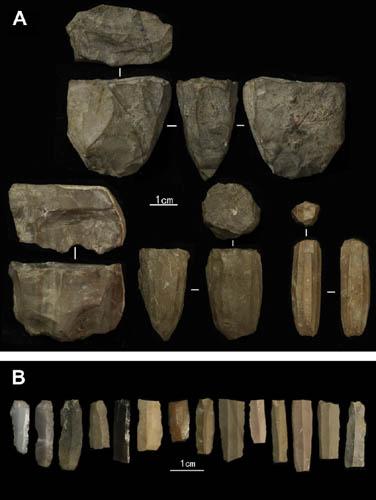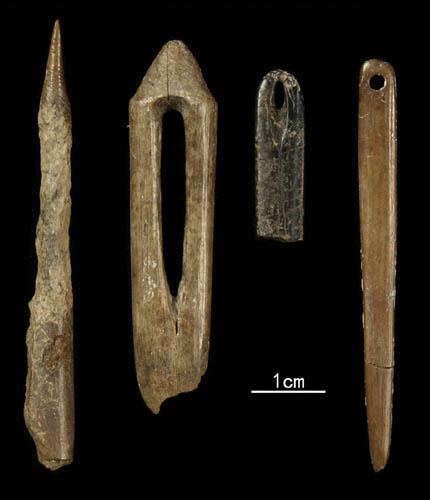Institute of Vertebrate Paleontology and Paleoanthropology
Source - http://phys.org/news/2013-06-microblades-mobile-north-central-china.html

Fig.1. Microblade cores and preforms (A),and microblades (B) from Shuidonggou 12. Credit: YI Mingjie
Though present before the Last Glacial Maximum (LGM, around 24,500–18,300 years ago), microblade technology is uncommon in the lithic assemblages of north-central China until the onset of the Younger Dryas (YD, around 12,900–11,600 years ago). Dr. GAO Xing, Institute of Vertebrate Paleontology and Paleoanthropology (IVPP), Chinese Academy of Sciences, and his team discussed the origins, antiquity, and function of microblade technology by reviewing the archaeology of three sites with YD microlithic components, Pigeon Mountain (QG3) and Shuidonggou Locality 12 (SDG12) in Ningxia Autonomous Region, and Dadiwan in Gansu Providence, suggesting the rise of microblade technology during Younger Dryas in the north-central China was connected with mobile adaptations organized around hunting, unlike the previous assumption that they served primarily in hunting weaponry. Researchers reported online in the Journal of Anthropological Archaeology 32 (2).
The late Pleistocene featured two severe, cold–dry climatic downturns, the Last Glacial Maximum and Younger Dryas that profoundly affected human adaptation in North China. During the LGM archaeological evidence for human occupation of northern China is scant and North China's earliest blade-based lithic industry, the Early Upper Paleolithic (EUP) flat-faced core-and-blade technology best known from Shuidonggou Locality 1 (SDG1) on the upper Yellow River, was replaced by a bipolar percussion technology better suited to lower quality but more readily available raw material.
Researchers presented evidence that the initial rise in microblade use in North China occurs after 13,000 years ago, during the YD, from three key sites in west-central northern China: Dadiwan, Pigeon Mountain and Shuidonggou Locality 12 (SDG12). In this region composite microblade tools are more commonly knives than points. These data suggest the rise of microblade technology in Younger Dryas north-central China was mainly the result of microblades used as insets in composite knives needed for production of sophisticated cold weather clothing needed for a winter mobile hunting adaptation like the residentially mobile pattern termed ''serial specialist.'' Limited time and opportunities compressed this production into a very narrow seasonal window, putting a premium on highly streamlined routines to which microblade technology was especially well-suited.
It has been clear for some time that while microblades may have been around in north-central China since at least the LGM, they become prominent (i.e., chipped stone technology becomes ''microlithic'') only much later, with the YD. This sequence suggests a stronger connection between microblades and mobility than between microblades and hunting. If microblades were only (or mainly) for edging weapons, their rise to YD dominance would suggest an equally dramatic rise in hunting, making it difficult to understand why a much more demanding microblade technology would develop to facilitate the much less important pre-YD hunting. In any event, the SDG12 assemblage is at odds with the idea of a hunting shift. No more or less abundant than in pre-YD assemblages (e.g., QG3), formal plant processing tools suggest a continued dietary importance of YD plants, and there is no evidence for hunting of a sort that would require microblade production (i.e., of weaponry insets) on anything like the scale in which they occur. A shift to serial specialist provides a better explanation .

Fig.2. Bone needles and stitching awl from Shuidonggou 12. Credit: YI Mingjie
Serial specialists are frequently forced to accomplish significant amounts of craftwork in relatively short periods of time. Microblade technology is admirably suited to such streamlined mass-production, and this is exactly what the SDG12 record indicates. The intensity with which SDG12 was used and the emphasis on communal procurement suggests a fairly short-term occupation by groups that probably operated independently during the rest of the year, almost certainly during the winter. SDG12 was most likely occupied immediately before that in connection with a seasonal ''gearing up'' for winter, perhaps equivalent to the ethnographically recorded "sewing camps'' of the Copper Inuit and Netsilik Inuit.
"Our study indicates that YD hunter-gatherers of north-central China were serial specialists, more winter mobile than their LGM predecessors, because LGM hunter-gatherers lacked the gear needed for frequent winter residential mobility, winter clothing in particular, and microblade or microlithic technology was central to the production of this gear. Along with general climatic amelioration associated with the Holocene, increasing sedentism after 8000 years ago diminished the importance of winter travel and the microlithic technology needed for the manufacture of fitted clothing", said first author YI Mingjie of the IVPP.
"We do not argue that microblades were not used as weapon insets (clearly they were), or that microblade technology did not originally develop for this purpose (clearly it might have). We merely argue that the YD ascendance of microblade technology in north-central China is the result of its importance in craftwork essential to a highly mobile, serial specialist lifeway, the production of clothing in particular. While microblades were multifunctional, this much is certain: of the very few microblade-edged tools known from north-central China all are knives, none are points. If microblades were mainly for weapons it should be the other way around", said corresponding author Dr. Robert L. Bettinger, University of California – Davis.